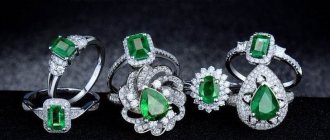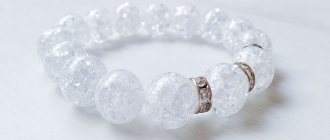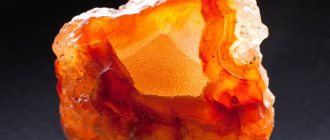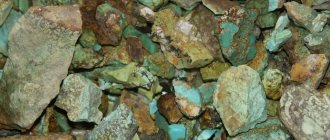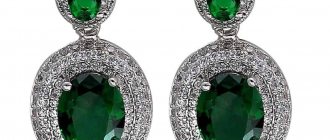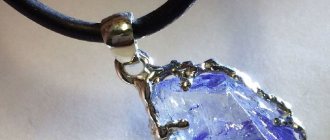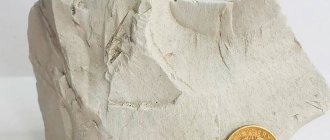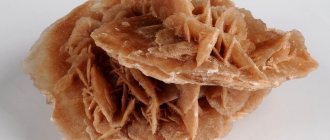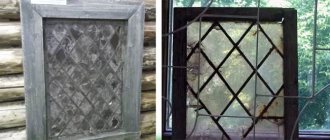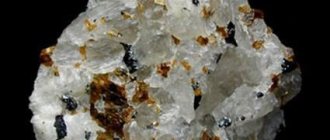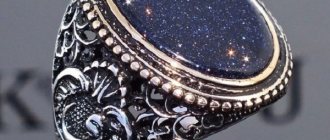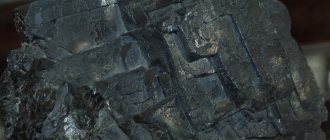The chemical nature of the mineral zoisite is a silicate containing calcium and aluminum. Depending on the amount of other metals in its composition, the stone acquires different shades: green and olive due to iron, blue due to the presence of vanadium, greenish-blue due to the content of chromium and vanadium. Zoisite is characterized by a matte or glassy luster, varying degrees of transparency and high fragility. The mineral is insoluble in acids; when melted, it turns into a white bubbly mass.
Zoisite deposits
Zoisite is widespread on our planet. Its large deposits are located in the USA, Switzerland, Norway, and Austria. Bulgaria is known for its deposits of semi-precious stone. In Russia, zoisite is mined in Altai, the Urals, and Transbaikalia. But transparent pieces of jewelry quality are supplied by African countries such as Tanzania, Kenya and Zambia. It is interesting that the transparency and brilliance of zoisite crystals depends on the depth of their occurrence. The closer to the surface, the brighter and cleaner the stones can be obtained.
Place of Birth
Zoisite stone is quite common in the earth's crust. Countries such as:
- Austria;
- Norway;
- USA;
- Switzerland;
- Bulgaria;
- Russian Federation - Transbaikalia, Ural.
Gemstones of amazing beauty were discovered in Africa, in Tanzania. In honor of the country where they are mined, they were called tanzanites. We have a separate article about these gems, which are very different from other zoisites.
History of zoisite
— Advertising —
At the end of the 18th and beginning of the 19th century, Baron Sigmund Zois von Edelstein lived in Slovenia, a province of Austria-Hungary, who was interested in biology, ornithology and mineralogy. In addition, he was known as a philanthropist who generously supported scientists and artists. Once on an expedition, the baron discovered greenish transparent crystals, which, after examination, were recognized as a new variety and received their name in honor of the discoverer. According to the name of the area where Zoiz first found the stone, it is also sometimes called "zahualpit".
But the mixture of zoisite with plagioclase was later called “Saussurite”, since it was discovered by the Swiss biologist Horace Saussure.
Origin and history
The mineral zoisite is formed in the thickness of metamorphic or glaucane rocks. It is also found in skarns, where it accompanies rock crystal deposits. It was here that the stone was first discovered. This happened in 1805 in the Alps, on the territory of the then Austrian Empire. The original name of the gem sounded like zaulpite - in honor of the mountains where it was discovered.
Previously, cyosite was considered unsuitable for jewelry, but with the advent of new technologies, the situation has changed.
The stone received its modern name in honor of Sigmund Zois, a Slovak mineralogist. He studied the gem for a long time, fascinated by its beauty. He also supported his fellow researchers with impressive financial resources. Grateful scientists decided to perpetuate the name of Zois, agreeing to call zaulpite zoisite.
Initially, the stone did not gain much popularity. It is difficult to process due to its fragility. But by the beginning of the 20th century, when jewelry technology was improved, the crystal took its rightful place on the shelves of jewelry stores.
Physicochemical characteristics of zoisite
According to its chemical structure, the mineral zoisite is a silicate that, in addition to silicon oxide, contains aluminum, iron and metal impurities (iron, vanadium, chromium).
The stone is painted in shades of blue, green and their combinations, depending on the specific chemical composition of the sample. Zoisite is characterized by double fusion, so with a well-calculated blow to the stone it is possible to obtain a perfectly even chip. But as soon as you change the angle of exposure, this effect disappears. Zoisite does not dissolve in acids; during melting it bubbles and forms a white foam. Hardness on the Mohs scale 6, density 3.5 g/cm3.
Decorations
According to history, for half a century, zoisite was used exclusively as a cheap stone used for various types of decoration.
In 1954, high-quality rocks of the mineral with beautiful variegated shades were discovered in Tanzania.
At the same time, jewelers became interested in the stone. A little later, in 1967, rare types of zoisite with a transparent structure were discovered, which subsequently became widely used in jewelry.
Zoisite has several varieties, each of which has found its current application in the field of jewelry creation. For example, opaque minerals are ideal for creating jewelry, but transparent ones are ideal for expensive jewelry.
Zoisite jewelry is spectacular and unique, which is why it is perfect for bright women who are used to attracting everyone's attention. The stone perfectly emphasizes their beauty and individuality.
This is interesting: zoisite rings are not put into mass production because they are in low demand due to their fragility. Moreover, it is rings that are lucky amulets.
The gem is devoid of any danger or hidden negative energy, making it suitable for everyone who wants to experience positive emotions.
Types of zoisite
— Advertising —
There are several subspecies for zoisite:
- Tanzanites are transparent blue stones that representatives of the Tiffany jewelry house examined in Tanzania. These are very rare and for this reason very expensive gems.
- Thulites are bright pink unusual stones that got their name from the ancient Norwegian state of Thul, where their first samples were found.
- Aniolites are a mixture of green zoisite and pink or red ruby. Sometimes there are specimens painted blue-violet and similar in appearance to sapphires. Expensive variety.
- Saussurites - consist of zoisite and plagioclase, have a characteristic green tint. Externally they resemble jasper.
Varieties and colors
There are four varieties of zoisite. They differ in color characteristics, composition and jewelry value:
- Thulite is a deep pink or dark red stone. Sometimes there are samples with alternating red and white stripes. Named after the island of Thul, located in Norway. The mineral contains manganese, which gives it a pink tint. Thulite is cabochonized (polished and shaped into smooth beads) and inserted into jewelry. In addition, carvings are made from it.
- Tanzanite is a rare blue mineral, the reserves of which are found only in one place - in Tanzania near Mount Kilimanjaro in Arusha province. The sapphire-colored mineral is highly valued by jewelers, is included in the Tiffany house catalog and costs a fortune.
- Saussurite is a green zoisite containing silicates. In appearance it resembles jasper.
- Aniolite is a unique natural formation: ruby in zoisite. The unique combination of green with a dark pink tint has transferred the mineral from the category of ornamental stones to the category of precious stones. This is the most expensive and rare representative in the family of such gems.
Magical properties of zoisite
Zoisite helps maintain peace and warm, friendly relationships in the family.
For this purpose, it is recommended to keep an amulet - a zoisite human figurine - in the house (but not in a visible place). In addition, the stone helps a person overcome mental weakness and indifference. The energy of zoisite is aimed at revealing the talents of the owner of the stone, searching for his individual and independent path. With its help, a person learns to express emotions, develops eloquence and the ability to speak in front of a large audience. Amulets made from this mineral are suitable for anyone who performs a lot in public (actors, artists, public figures, teachers).
The magical properties of zoisite depend on its color. For example, the ruby variety (aniolite) promotes harmony and peace; it becomes a source of vital energy and self-confidence. Aniolytes are used for meditation. Lavender and blue tanzanites serve as a means of contacting higher powers. The combination of zoisites with moldavites and aquamarines cleanses a person of negative energy.
The properties of zoisite appear over time and can accumulate, so it is important to carry amulets with this stone with you constantly for a long time in order to get a noticeable effect.
Varieties
According to the color that predominates in the crystal, the following types of zoisite are distinguished:
Tanzanite
It is one of the most recognizable types of zoisite. It has a bright blue color, similar to the shade of the deep sea. It is considered the most expensive representative of zoisite, since it is extremely rare in nature.
However, the jewelry industry has learned to produce artificial “versions” of tanzanite by heating the mineral to high temperatures.
Aniolite
It is a unique mineral that combines zoisite and ruby. It is this combination that determines its amazing color: zoisite particles are distinguished by a rich green color, and the inclusions that penetrate it have scarlet, cherry, and pink hues.
The price of aniolyte also varies at fairly high ranges.
Thulite
Another variety of zoisite, which has a bright pink color and is very similar to rhodonite. The cost of this mineral is in the average price category.
Saussurite
A stone that has a variegated color with a predominance of rich green color. Upon closer inspection, Saussurite is distinguished by different shades. This property is determined by the presence of plagioclase particles in the stone.
The varieties of zoisite listed above have a fairly high price range, which was largely influenced by the Tiffany jewelry house, which specializes in the production of zoisite jewelry.
Prices for some jewelry made from this stone can reach a maximum of $500 per gram of carat.
Also, the high cost of zoisite was influenced by the interest in it of the famous artist Pablo Picasso, who became the founder of cubism, one of the trends in painting.
Healing properties of zoisite
The healing qualities of zoisite are aimed at preventing cardiovascular diseases; the mineral has a calming effect and helps get rid of insomnia.
In folk medicine, the gem has found use in the treatment of the pancreas, spleen and lungs. It helps relieve inflammatory processes, strengthen the immune system and normalize metabolism. In lithotherapy, polished small zoisites are used in the treatment of diseases of the spine - they are applied to the sore spot. Zoisite and ruby go well together as healing stones. Together they normalize blood pressure, relieve headaches, help with migraines, and relieve pain. In addition, they are used in the treatment of impotence, both female and male infertility.
Healing properties
Alternative medicine attaches great importance to the healing properties of the gem.
Zoisite is effective for the following diseases:
- heart and circulatory system;
- reduces blood pressure;
- has a beneficial effect on the nervous system;
- cures sleep disorders;
- eliminates headaches;
- heals the spleen and pancreas;
- normalizes metabolic processes in the body;
- eliminates inflammation;
- stimulates the immune system;
- eliminates pain in the spine with direct contact;
- heals diseases of the female reproductive system;
- increases potency in men.
Applications of zoisite
Zoisite, due to its qualities and wide color palette, is actively used in the jewelry industry. Jewelry (pendants, pendants, earrings) is made from transparent specimens, and costume jewelry, amulets, talismans and amulets are made from opaque specimens. Large opaque samples serve as ornamental material for making bowls, vases, amphorae, figurines and sculptures.
Scope of application
Zahualpit is not used in industry or construction because it is a fragile and rare stone. It was used only in jewelry, the production of souvenirs and items for interior decoration.
Zoisite has been used as an ornamental stone for over 100 years. Inexpensive, accessible jewelry was made from it. Jewelers did not immediately recognize the decorative properties and value of this stone.
Interest in the mineral arose in the second half of the last century, when a green granular rock, zoisite aniolite, was found on the territory of the state of Tanzania, located in Africa. The stone is unusual in that it contains a ruby in its body. This sharply increased the status of the gem and affected its price.
Zoisite with ruby (aniolite) after firing turns into a real jewel and is sold very expensive.
The cost of 1 carat reaches $500. For a pendant, ring or brooch with such a stone you will have to pay 10-15 thousand dollars. This is a luxury available only to wealthy people, show business stars and members of high society. Less wealthy people can only see anionite in photographs and in museums of natural minerals.
Opaque zahualpits are used to make inexpensive jewelry, amulets, and souvenirs. Their cost is affordable to a wide range of people. The price of such products is:
- bracelets – 500 rub.;
- pendants – 1 thousand rubles;
- beads – 500-1200 rubles;
- brooch – 1200-1400 rubles;
- earrings – 400 rub.
Zoisite is a brittle mineral, so it is rarely used to make bracelets or rings. The range of budget and expensive jewelry made from such natural raw materials includes beads, brooches, pendants and earrings.
Zoisite colors
Zoisite crystals can be either transparent or opaque, and their color range is very diverse. Transparent zoisite can be colored yellow, grey, pink and green. Blue specimens are the rarest of all; in the sun they shimmer with violet and lilac. Opaque zoisite can be either monochromatic or multi-colored. Green stones often contain red ruby inclusions.
Wear and care
Zoisite should be worn constantly. In this way, you can become saturated with the beneficial properties of the stone and fully feel its effects.
Caring for the mineral comes down to monthly cleaning with running warm water. Subsequently, charging the gem is possible through solar radiation. Areas located close to rock crystal are ideal as storage places.
Despite the ambiguous attitude of numerologists and astrologers towards the described stone, zoisite cannot be taken away from its natural uniqueness and beneficial properties.
How to distinguish real zoisite from a fake
Rare varieties of zoisite are counterfeited quite often. When determining the authenticity of a mineral, the analysis begins with the assessment of black inclusions on its surface. Chaotic and shapeless spots are a clear sign of a fake, and the arrangement, like in kiwi seeds, indicates the authenticity of the sample. In addition, fakes often add too much ruby impurity in the form of red spots. In a thread of natural zoisite beads, such inclusions will appear on just a couple of beads. And if you split such a fake bead, it turns out that it is colored only on top.
How to identify a fake
Zoisite has status and is expensive; it is not surprising that the stone is counterfeited.
You can spot a fake:
- In natural stone, the spotting is chaotic, but clear.
- If ruby spots are rubbed, scratched or picked, the paint will come off on a fake.
- Natural zoisite is not loudly variegated.
- Glass is lighter than stone and heats up faster in your hands.
Imitation is easier to recognize in a necklace or bracelet. If all the beads have “ruby” inclusions, and the price is not exorbitant, it is a fake.
Zoisite and zodiac sign
Zoisite is a patron for those born under the sign of Aquarius, it will restrain their impulsiveness, and under the sign of Gemini, for whom it will help overcome laziness and streamline their goals and desires.
Zoisites will also be a good talisman against unpleasant events for Taurus and Libra. This stone should be worn with caution by hot-tempered and emotional Leo, Aries and Sagittarius. The effect of zoisite on them can be softened by rock crystal, moonstone, rose quartz or cat's eye.
Of the varieties of zoisite, aniolite is recognized as the patron saint for Aries, tanzanite for Virgo, and thulite for Gemini and Taurus.
Deposits and production
The mineral zoisite belongs to a group of metamorphic rocks that arose in the thickness of igneous and other precursor rocks under the influence of high temperatures and pressure. Zoisite crystals are found in cavities between layers of shale and in the thickness of marble deposits. In different parts of the planet, such a cluster usually contains some specific type of zoisite.
For example, in northern Tanzania, the most expensive variety of the mineral is mined, named tanzanite after this geographical area. Pink thulite is found in Norway, Switzerland, Namibia, as well as in Australian deposits and North Carolina. Aniolite is mined in the Urals, India, and Afghanistan. Yellow, green or pink clinozoisite crystals are found in the mountainous regions of Pakistan and Afghanistan.
Prices for zoisite products
The price for 1 carat of zoisite ranges from $50-500 depending on color and transparency. Beads, bracelets, earrings and rings made of opaque stones are priced cheaper than jewelry samples and are generally available to the consumer. So, earrings can be purchased for 5-10 dollars. Green zoisite beads 50 cm long cost about $15, a gray bracelet costs $15-20.
Where is the stone used?
Zoisite ring
Areas of application of zoisite - jewelry, decor, collecting:
- Transparent and translucent specimens go to jewelers. They are used in premium jewelry. The most popular are pendants, pendants, beads, and earrings made of zoisite.
- Opaque zoisites become large sculptures, bowls, vases, and small sculptures in the hands of stone carvers.
- The production of costume jewelry in silver or simpler frames has been established.
- They are used to make products of an esoteric assortment: balls, eggs, pyramids, and other amulets or talismans.
Collectors are hunting for interesting combined specimens of zoisites.
The magical properties of Cyosite with Ruby as a Stone of Being, strengthening the Self
The Cyosite Stone with Ruby, if its magical properties are similar to the person with whom it interacts, can become the Stone of Genesis. This means that it will strengthen the virtues of its Carrier, relieve fatigue, and give new strength. Essentially, as a Stone of Genesis, Cyosite with Ruby will make the person it approaches confident in their personal values in life, thorough, strong-willed, and striving for a healthy lifestyle.
Suitable for people according to their horoscope: Capricorn from December 22 to January 20
Suitable for people with the following temperament: Shayatiy (that’s what we call phlegmatic people)
The Cyosite Stone with Ruby, possessing many wonderful magical properties of the Earth Element, will support and strengthen all the best personal qualities of a long-smoldering, stubborn phlegmatic person. Remember that there are no “pure” temperaments, and the Cyosite Stone with Ruby in this capacity will find understanding with exactly one part of your personality. Therefore, it is better for you to understand what temperament still prevails in a person, and choose the Cyosite Stone with Ruby according to your shady temperament.
How to spot a fake
It should be noted that only samples found in nature can have healing and magical parameters. Therefore, before purchasing it, it makes sense to check its authenticity. To do this, you can use the following methods.
It is necessary to carefully examine the black inclusions. There are a lot of them in semi-precious stones. In natural zoisite they are distributed more or less evenly; in a separate sample they will be scattered chaotically throughout the stone.
Another way to distinguish a fake is as follows: the stone must be pressed against the skin. Natural stone will keep you cool. The fake will quickly heat up from the human body.
Zoisite containing inclusions of corundum, when illuminated by a UV lamp, will appear covered with small red spots.
Magical properties of Cyosite with Ruby as a Spiritual Stone
Cyosite with Ruby can become for any mature person the very Stone with which you can go into dream-like wonders, perform Slavic northern rituals, and attract the favor of the Native Gods. Here we show the spiritual relationship of magic stones with the Slavic Gods and Goddesses, whom we honor in the north. Each God or Goddess, of course, has more than one Stone, with the help of which one can perform rituals of clairvoyance and clairvoyance, secrecy, confession, and glorification of the Gods.
Touching the Higher Powers: Troyan - God of Witchcraft and Herbalism
This memorable, noble-colored Stone is beautiful in rites of appeal to the Mountain World. The magical properties of the Cyosite Stone with Ruby give us hope for the patronage of the thoughtful God Trojan, the God of Witchcraft and Herbal Medicine. Turning to Him will help you heal, increase your health, and live a prosperous life.
These are the magical properties of this Stone! Now you know the meanings and properties of the Cyosite Stone with Ruby, who it is suitable for and what it gives. We have tried to collect here the very essence for your acquaintance with the northern magic of Stones. What do you think about this Stone? Do you want to feel its power? Share in the discussion! For good!
Care instructions
Zoisite is a very fragile stone that requires careful handling. Considering that it is recommended to keep this gem with you at all times, you need to learn how to handle the talisman carefully:
- protect from shocks, falls, and any mechanical influences;
- remove during housework, despite the fact that the stone is resistant to chemicals;
- Do not expose to temperature changes.
The mineral does not like moisture, so it is better to store products in a dry place, separate from other minerals. If the stone comes into contact with sweaty skin, it must be wiped dry. The zahualpite is cleaned as the nugget becomes tarnished. For this, ordinary running water and a dry cloth for drying are suitable. It is possible to use special products for the care of precious stones.
Properties
Given the increased fragility of the stone, it is difficult for jewelers to process it. Zoisite does not dissolve when exposed to acids. When heated strongly, the mineral turns into a bubbly white mass.
| Description | Characteristic |
| Stroke color | White |
| Shine | Mother of pearl, glass |
| Transparency | Opaque, translucent |
| Kink | Uneven |
| Hardness | 6 |
| Specific gravity | 3,25 — 3,36 |
| singonia | Rhombic |
| Molecular weight | 454.36 |
| Typical impurities | Fe,Mn,Mg,Cr,Ti,Ca,Na,V,Sr,H2O |
| Cleavage | Perfect |
| Fragility | Yes |
| Type | Biaxial (+) |
| Refractive indices | nα = 1.696 - 1.700 nβ = 1.696 - 1.702 nγ = 1.702 - 1.718 |
| Maximum birefringence | δ = 0.006 – 0.018 |
| Pleochroism | Visible |
| Cell Options | a = 16.19Å, b = 5.54Å, c = 10.03Å |
Chemical formula Ca2Al3[Si2O7] [SiO4]O[OH].
Origin
In nature, the formation of the mineral occurs in metamorphic and glaucophane rocks. It is also not uncommon in crystal-bearing layers, skarns.
